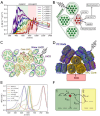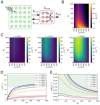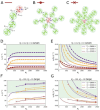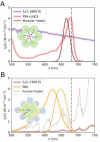Optimizing photosynthetic light-harvesting under stars: simple and general antenna models
- PMID: 39256265
- PMCID: PMC11413096
- DOI: 10.1007/s11120-024-01118-1
Optimizing photosynthetic light-harvesting under stars: simple and general antenna models
Abstract
In the next 10-20 years, several observatories will aim to detect the signatures of oxygenic photosynthesis on exoplanets, though targets must be carefully selected. Most known potentially habitable exo-planets orbit cool M-dwarf stars, which have limited emission in the photosynthetically active region of the spectrum (PAR, nm) used by Earth's oxygenic photoautotrophs. Still, recent experiments have shown that model cyanobacteria, algae, and non-vascular plants grow comfortably under simulated M-dwarf light, though vascular plants struggle. Here, we hypothesize that this is partly due to the different ways they harvest light, reflecting some general rule that determines how photosynthetic antenna structures may evolve under different stars. We construct a simple thermodynamic model of an oxygenic antenna-reaction centre supercomplex and determine the optimum structure, size and absorption spectrum under light from several star types. For the hotter G (e.g. the Sun) and K-stars, a small modular antenna is optimal and qualitatively resembles the PSII-LHCII supercomplex of higher plants. For the cooler M-dwarfs, a very large antenna with a steep 'energy funnel' is required, resembling the cyanobacterial phycobilisome. For the coolest M-dwarfs an upper limit is reached, where increasing antenna size further is subject to steep diminishing returns in photosynthetic output. We conclude that G- and K-stars could support a range of niches for oxygenic photo-autotrophs, including high-light adapted canopy vegetation that may generate detectable bio-signatures. M-dwarfs may only be able to support low light-adapted organisms that have to invest considerable resources in maintaining a large antenna. This may negatively impact global coverage and therefore detectability.
Keywords: Antennae; Astrobiology; Cyanobacteria; Light-harvesting; Thermodynamic models.
© 2024. The Author(s).
Conflict of interest statement
There are no conflicts of interest to disclose.
Figures





Similar articles
-
Predicting the diversity of photosynthetic light-harvesting using thermodynamics and machine learning.PLoS Comput Biol. 2025 Mar 11;21(3):e1012845. doi: 10.1371/journal.pcbi.1012845. eCollection 2025 Mar. PLoS Comput Biol. 2025. PMID: 40067883 Free PMC article.
-
On the interface of light-harvesting antenna complexes and reaction centers in oxygenic photosynthesis.Biochim Biophys Acta Bioenerg. 2019 Nov 1;1860(11):148079. doi: 10.1016/j.bbabio.2019.148079. Epub 2019 Sep 10. Biochim Biophys Acta Bioenerg. 2019. PMID: 31518567 Review.
-
Structure of a C2S2M2N2-type PSII-LHCII supercomplex from the green alga Chlamydomonas reinhardtii.Proc Natl Acad Sci U S A. 2019 Oct 15;116(42):21246-21255. doi: 10.1073/pnas.1912462116. Epub 2019 Sep 30. Proc Natl Acad Sci U S A. 2019. PMID: 31570614 Free PMC article.
-
Evolution of flexible non-photochemical quenching mechanisms that regulate light harvesting in oxygenic photosynthesis.Curr Opin Plant Biol. 2013 Jun;16(3):307-14. doi: 10.1016/j.pbi.2013.03.011. Epub 2013 Apr 11. Curr Opin Plant Biol. 2013. PMID: 23583332 Review.
-
Transcriptomic and photosynthetic analyses of Synechocystis sp. PCC6803 and Chlorogloeopsis fritschii sp. PCC6912 exposed to an M-dwarf spectrum under an anoxic atmosphere.Front Plant Sci. 2024 Jan 18;14:1322052. doi: 10.3389/fpls.2023.1322052. eCollection 2023. Front Plant Sci. 2024. PMID: 38304456 Free PMC article.
Cited by
-
Predicting the diversity of photosynthetic light-harvesting using thermodynamics and machine learning.PLoS Comput Biol. 2025 Mar 11;21(3):e1012845. doi: 10.1371/journal.pcbi.1012845. eCollection 2025 Mar. PLoS Comput Biol. 2025. PMID: 40067883 Free PMC article.
References
-
- Akhtar P, Caspy I, Nowakowski PJ et al (2021) Two-dimensional electronic spectroscopy of a minimal photosystem i complex reveals the rate of primary charge separation. J Am Chem Soc 143:14601–14612 - PubMed
-
- Anglada-Escudé G, Amado PJ, Barnes J, et al (2016) A terrestrial planet candidate in a temperate orbit around Proxima Centauri. Nature 536(7617):437–440. 10.1038/nature19106, arXiv:1609.03449 [astro-ph.EP] - PubMed
-
- Arecibo PU (2024) The Planetary Habitability Laboratory @ UPR Arecibo. https://phl.upr.edu/home
-
- Arnold L, Gillet S, Lardière O et al (2002) A test for the search for life on extrasolar planets* - looking for the terrestrial vegetation signature in the earthshine spectrum. A &A 392(1):231–237. 10.1051/0004-6361:20020933
-
- Arp TB, Kistner-Morris J, Aji V et al (2020) Quieting a noisy antenna reproduces photosynthetic light-harvesting spectra. Science 368(6498):1490–1495. 10.1126/science.aba6630 - PubMed
MeSH terms
Substances
Grants and funding
LinkOut - more resources
Full Text Sources

